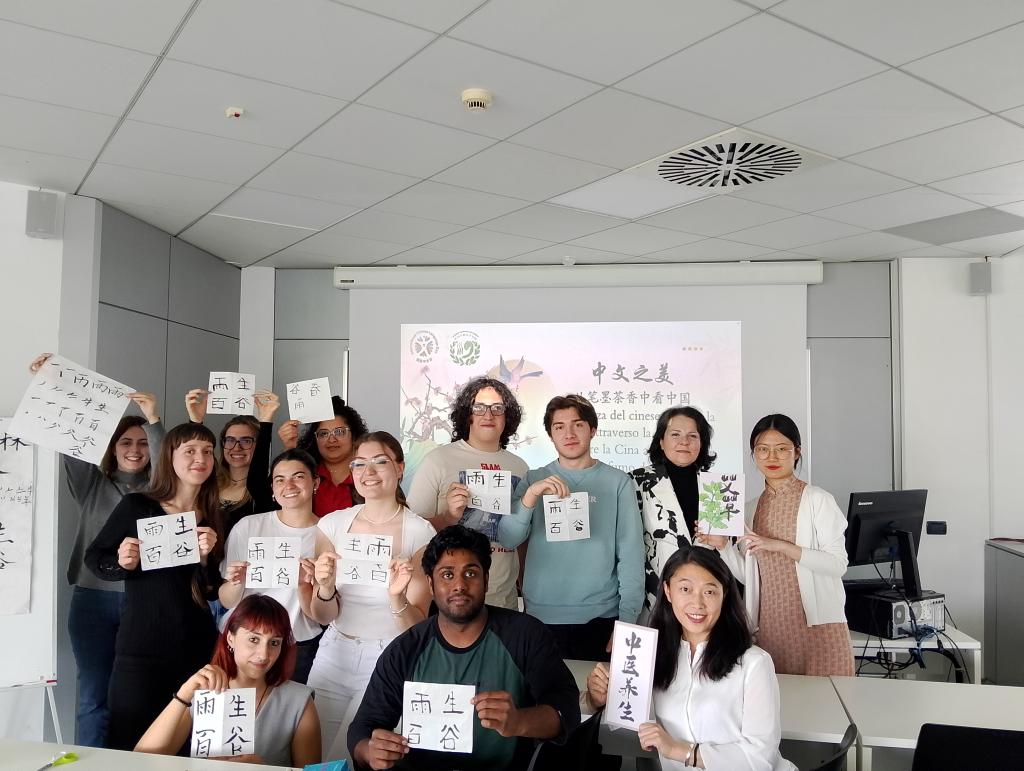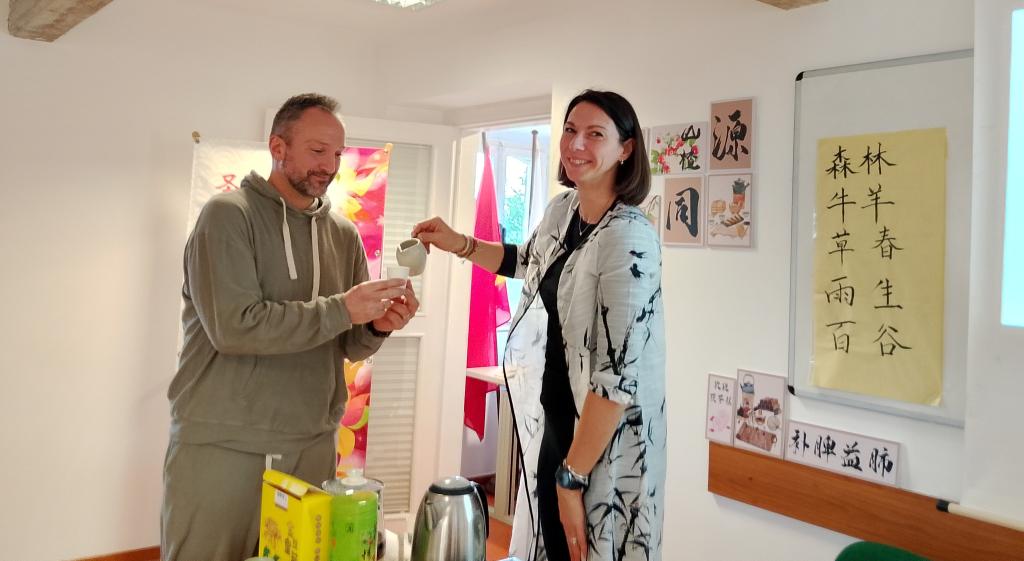Recently, San Marino Confucius Institute has successfully hosted a series of cultural activities to celebrate the 2025 United Nations Chinese Language Day. Designed for all age groups, these activities covered various contents such as calligraphy art experience, tea culture tasting, understanding food and medicine homology, and traditional Chinese exercises practicing, etc.. The promotion received positive responses and enthusiastic participation of nearly fifty people from San Marino University, Scout organizations and the public, fully showcasing the unique appeal and profound heritage of the Chinese traditions.
Promoting Language and Culture: A Cultural Dialogue between Chinese Language Day and Grain Rain
Established in 2010 by the United Nations to promote the equal use of the six official languages, Chinese Language Day is celebrated every year which coincides with the traditional Chinese solar terms Grain Rain, symbolizing the harmony between language and natural cycles. At the beginning of the activity, the teachers from the San Marino Confucius Institute introduced the background of the establishment of the Chinese Language Day, the international status of Chinese language and the cultural symbolism of Grain Rain in Chinese solar terms through vivid explanations and multimedia presentations. The activity enhanced the participants' knowledge and intrigued further interests in the history of the Chinese language and culture.
Hands-on Cultural Exploration: From Small Seal Character Riddle to Calligraphy Copying
One of the highlights of this activity was the calligraphy experience. First, the teacher led the students to start from an interactive game of “Small Seal Character Riddle”, to an educational and entertaining process of explaining the origin and evolution of Chinese characters through recognizing the ancient forms, like oracle-bone inscriptions and the Small Seal Characters, allowing them to experience the uniqueness of the Chinese characters in a relaxing atmosphere. Then, in the calligraphy copying experience, students used brushes to write down Chinese characters, through the charismatic strokes of “horizontal, vertical, left and right downward”. In a special activity for the Scouts organization, the teachers guided the children to craft a flowery collage of the Chinese character “春” rhyming with the season spring, with calligraphy and painting tools, and natural materials such as twigs, merging fun and art. The children were inspired to explore more Chinese characters through the activities.

Tea Ceremony Participation: An Immersive Experience of Art and Aesthetics
The tea culture session introduced the traditional Chinese tea ceremony process: brewing techniques and drinking etiquette for different tea types such as green tea, oolong tea, black tea, etc., alongside tastings of oolong tea, green tea, chrysanthemum tea, etc. Under the instructors’ guidance, participants changed into tea attire to experience the whole process from tea brewing to tea tasting and toasting, so as to further appreciate its beauty, and to realize the spirit of China's unique tea culture of “He” and “Jing”, which stands for harmony and tranquility. Enjoying tea with tea snacks, everyone deepened their understanding of the aesthetics of traditional Chinese lifestyle.

Health-and-Culture Integration: Traditional Chinese medicine features in the springtime
As a Confucius Institute with a focus on traditional Chinese medicine culture, the event has especially integrated elements of health and culture. Displays on food and medicine homology (药食同源) decorated in Chinese styles in the main cultural classroom attracted everyone's attention. During the tea culture experience session, the instructors also explained the unique efficacy of different teas in regulating the bodily functions, combining theories of food and medicine homology .
In particular, the activity took cassia seeds as an example, explaining in detail their Chinese medicine effects of clearing the liver and improving eyesight, moistening the intestines and relaxing the bowels, and demonstrating how to brew cassia seeds with chrysanthemum to nourish the liver, protect the eyes and soothe the emotions. Guided by the instructors, everyone tasted cassia seeds and chrysanthemum tea and showed great interest in its unique aroma and functions. Many participants said that it was not only a taste treat, but also a precious experience to gain a deeper understanding of the oriental wisdom of health care. The activity was well-received in full vigor.
In addition, the activity also arranged an outdoor session of Baduanjin (八段锦) practice, in which participants were guided to stretch their bodies and relax their minds, and introduced to the effectiveness of Baduanjin in regulating Qi and blood, enhancing physical fitness, nourishing the liver and protecting the spleen. This medicinal fitness exercise is an integration that demonstrates a connotation of wellness and culture behind Chinese Language Day activities, resonating strongly with participants.

Promoting Cultural Communication: Language Teaching and Cultural Communication Go Hand in Hand
The series centered on “United Nations Chinese Language Day” not only provided San Marino and neighboring people with valuable opportunities to have close contact with Chinese culture, but also underscored the continuous efforts of the San Marino Confucius Institute in promoting Chinese language teaching locally and cultural exchanges bilaterally. Through the integrated communication path of “language + culture”, the Confucius Institute is committed to creating an important platform for local people to learn Chinese language and experience Chinese culture, and bridging for more friendly exchanges between China and San Marino.
In future, San Marino Confucius Institute will continue to uphold the principle of “teaching for mutual benefit and cultural exchange”, carry out more Chinese language teaching and cultural exchange activities with local characteristics and international vision, and continuously bring in new motivation into exchanges between China and San Marino.
